We want our guinea pigs to stay active and healthy for their whole life. But, over time, you will see that your guinea pig is getting lethargic and started sleeping a lot. That is just one of the common signs of old age in guinea pigs. There are many other signs you should look out for.
Loss of vision, change in the color of fur, sleeping a lot, or loss of hearing indicate that your guinea pig is getting older. You will also notice a loss in weight, mobility problems, inability to groom, and stress due to changes in the environment. Also, aging can develop a range of diseases, such as heart disease, dental issues, kidney disease, respiratory illness, and urinary tract infection.
If your old guinea pig has received good quality health care throughout their entire life, you will not be able to recognize some of the signs.
But the other symptoms will be prevalent, so you have to adjust the lifestyle of your guinea pig accordingly. As your guinea pig gets old, they will depend more on you to stay healthy and happy.
Guinea pig aging process
| Human Age | Guinea Pig Age |
|---|---|
| 0-8 years | 0-3 months |
| 9-16 years | 4-6 months |
| 17-30 years | 6 month-1 year |
| 31-40 years | 1-3 year |
| 40-60 years | 3-5 year |
| 60+ years | 5 year+ |
As compared to humans, a guinea pig can grow pretty quickly. Guinea pigs can change from baby guinea pig to adult guinea pig within one year. Thus, this can make a vast difference in the ages of humans and guinea pigs.
We can easily calculate the age of guinea pigs once the first year of a guinea pig is over. A guinea pig will grow 10 years older when the human grows one year old.
Signs of aging in guinea pigs
Guinea pigs can survive only for 5 to 8 years, in which when a guinea pig reaches 5 years of age, they are considered seniors.
When guinea pigs enter in their senior years, then they come across with different signs of aging which are explained below:
Change in color of coat
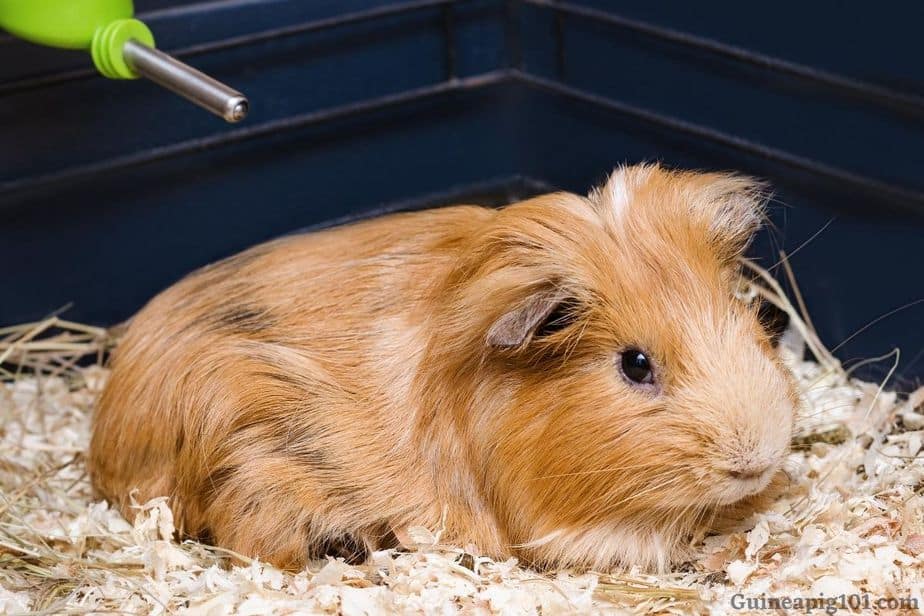
If a guinea pig is getting old, then their fur will also become white or grey. Also, the fur on their coats can become more elegant and thinner.
It will become much rougher or harsh in the texture than before. You will get to see that these grey hairs are behind and around their ears.
It is difficult to find a greying coat on those guinea pigs who already have a white or grey coat. In this case, you will need to have a look for other signs of the aging of your guinea pig.
Not all guinea pig’s coat turns grey, but you will start noticing a change in the color of the coat for sure.
Loss of vision
The eyesight of old guinea pigs will start deteriorating. It can develop some ocular issues for example:
- Cataracts
- Glaucoma
- Blindness
- Blocked tear ducts
- Conjunctivitis
Because of the parasitic or bacterial infection, guinea pigs can grow cataracts at their birth. Also, over some time, guinea pigs can develop cataracts, causing a slow loss of vision as per their ages, and in the end, they become blind.
The treatment to remove cataracts can be surgical to restore the eyesight of your old guinea pig, but it can be risky as well.
Glaucoma is a sizeable medical term that shows any situations in which extreme high pressure is enforced on guinea pigs’ eyes. It is uncommon for a guinea pig to have glaucoma on its own.
Rather than this, a guinea pig will be more likely to suffer related to the ocular conditions that can cause glaucoma, i.e., conjunctivitis and blocked tear ducts. If they are left untreated, then at the end, this can give rise to blindness.
Blind guinea pigs don’t need to live in a discouraging or depressing life. A blind guinea pig will be able to adapt to their newly discovered condition over time, depending on their smell and sense of hearing to get around.
Make sure that you should declare that you are nearby or allow your guinea pig to smell you so that they will not get frightened or scared from you when you reach them.
You can also put water, some food, and their litter box at the same place in their enclosure. Hence, from this, your guinea pig will be able to remember where they want to go for these things.
When the tear duct of your guinea pig is blocked, then your guinea pig’s eyes will become watery. The extra amount of tears can also flow down on their face, which makes the fur and skin slightly wet and causes a bacterial infection that can worsen the problem.
And later on, this will give rise to fur loss, inflammation, and constant growth of pressure in the eye of guinea pigs that will cause glaucoma.
When the tissues around an eye of guinea pig become provoked, at that time, conjunctivitis occurs. That will not only cause watery eyes, but also it can cause blindness and glaucoma if they are left untreated.
Loss of hearing
Guinea pig’s sense of hearing is very sharp, as, from that, they can hear the sounds clearly that even the ears of humans can’t understand.
A guinea pig can twirl both of their ears around 270 degrees very freely to observe the number of sounds from 2 miles away.
Sadly, this sharp sense of hearing will start getting dull when your guinea pig gets older and they can even become deaf at some point.
Those guinea pigs who have drooping ears, they are more likely to have the problems of the ear due to how their skull is built or shaped.
Because the ears of guinea pig, instead of staying up, they automatically flop down, a guinea pig with their drooping ears are more likely to suffer from infections of the ear, narrowed ear canals, pain in ears, and an extra amount of the ear wax build-up.
Over time, if they are left untreated, then all these can make your guinea pig deaf permanently. You have to take that guinea pig with drooping ears to the veterinary surgeon at regular intervals for the check-ups and cleaning to make sure that their ears stay healthy and clean.
But if your guinea pig was born deaf, it will heavily depend on their sense of hearing. Not only will it help the guinea pig to detect the predators probably, but also it will help them to understand and learn the commands and their environment.
If the ears of guinea pigs do not jerk in the direction of the noise or don’t react to the strange or loud sound, you will get to know that your guinea pig is losing their hearing.
A guinea pig can be deeply distressed when losing the hearing, so you have to be more patient and gentle with their care than earlier. Also, a deaf guinea pig can become violent towards humans.
Try to do your best to touch your guinea pig gradually and within the area of their vision. Also, allow your guinea pig to smell you so that they can make sure that you are a danger or not. Apart from this, the behavior of guinea pigs will not change that much.
Change in sleep pattern
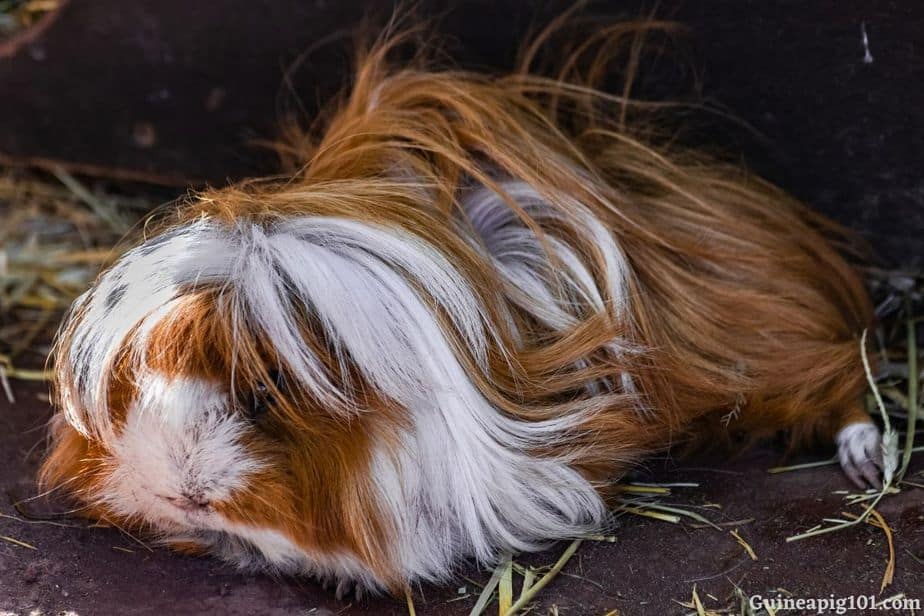
When a guinea pig comes into the middle age, on one occasion, their unlimited energy will start decreasing.
Also, your guinea pig can sleep for longer than they used to and they will not be able to play with you as they used to do earlier. When your guinea pig’s activities are reducing, then this means that they are becoming older.
When your guinea pig wants to sleep and relax, it is best not to disturb them. Though, in the day, many of the time, your guinea pig will feel energetic, so during these periods, you need to allow them to play.
Guinea pigs are the crepuscular creatures, which mostly appear or become active in the twilight. During their activeness, if your guinea pig is not in the mood to move around, then this means that they have the problem of guinea pig mobility.
Mobility problems
The condition which is typical for an old guinea pig is arthritis, especially osteoarthritis.
Those guinea pigs who have arthritis will have joint inflammation, which can be painful and slow down the movement.
The signs of arthritis in guinea pigs include:
- Increase in-ear wax buildup
- Doesn’t enjoy being handled or touched
- Difficulty moving around
- Difficulty in eating cecotropes
- Strange, wobbly walk
- Losing the balance on their back legs
- Difficulty jumping over small objects or onto high surfaces
- Reduced grooming, especially around their bottom
Cartilage in the joints helps smooth movement and but even that starts to wear down over a period, leading to arthritis.
If you don’t cheer up your guinea pig to play and exercise, they will probably become obese or overweight. When their weight puts the pressure in their joint, then it can cause wear and tear, in turn, which causes arthritis.
Infection or joint injury can also be a cause of arthritis. If you leave arthritis untreated, then it can lead to a loss in muscle leading to mobility issues.
It is advisable to see your veterinary surgeon when you believe that your guinea pig has arthritis.
To relieve your guinea pig’s joint pain, you can give a mutual massage to your guinea pig. Your veterinary surgeon can specify NSAIDs (non-steroidal anti-inflammatory drugs).
Also, a veterinary surgeon can recommend to you some ways to alter the diet of your guinea pig, so that they can lose the weight. A high-fiber, low-fat diet of a guinea pig is essential for the best or most favorable health.
Luckily, not all old guinea pigs need to have the problem of mobility. Some of the guinea pigs will continue to stay healthy and active, just like when they were younger. But still, it is better to observe your guinea pig make sure that they will not develop any problem related to mobility.
Grooming issues

You can catch your guinea pig cleaning their ears, licking its paws, or craning their head to lick themselves clean. A guinea pig doesn’t want to be dirty, and they are quite careful in cleaning themselves to make sure that they remain clean.
Your guinea pig may have developed arthritis if they are having problems in grooming themselves. The bottom of the guinea pig must remain clean to avoid the urine scalding, which occurs when the urine soaks into the fur of guinea pigs.
Generally, you need not give a bath to your guinea pig, but in this situation, you will need to wash the bottom of your guinea pig regularly, so that they will not have to push themselves to do so. Also, you need to clean the fleece or any other bedding regularly where they lie on.
Because of arthritis, even the smallest jumps are also tricky for your guinea pig. And, this can be impossible or hard for your guinea pig to use their litter box.
Unable to use litter box, tunnels, etc.
Another sign that your guinea pig can have arthritis is that an older guinea pig is not using their litter box. However, this difficulty is elementary to solve.
It can help if you arrange a bathroom mat that can be placed on the floor for your guinea pig to use rather than a box on which a guinea pig has to jump.
Hence, this can help your guinea pig to stand in for themselves without hopping or climbing over any barrier in their path. You can just clean or take the pads to throw away and change the pads with the new ones.
Weight loss
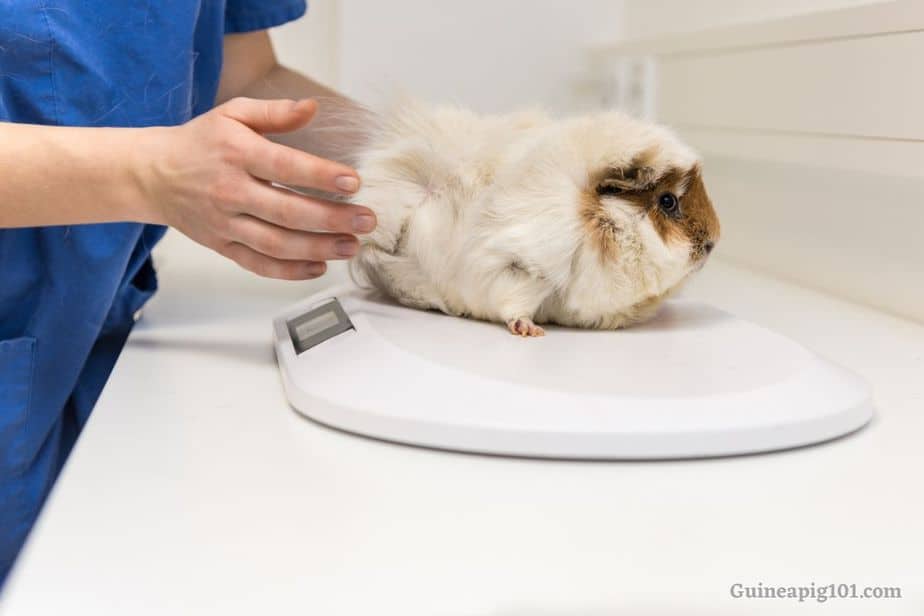
The weight of a guinea pig will change when they become older. According to their weight change, the owner needs to change the diet of their guinea pig. Don’t give many pellets to your guinea pig if they have become overweight.
On the other hand, if your guinea pig’s weight is less, you can increase the quality of pellets to feed your guinea pig every day.
You can give your guinea pig alfalfa pellets, which contain extra calories for your guinea pig’s weight gain.
Despite this, if your guinea pig still appears to be losing weight, then you need to take them to your veterinary surgeon, as this can be a sign of some severe digestive or dental disorder.
Stress due to change in environment
Guinea pigs can be susceptible to sudden changes in temperature, and their tolerance level goes down further as they age up.
In the cold climate, guinea pigs tend to be well, though guinea pigs will start to eat more during the winter season to keep warm.
On the other hand, the extra amount of heat can be stressful for your guinea pig.
The only cooling off method for guinea pigs is panting, as guinea pigs can’t sweat. However, panting is usually a sign of overheat and there is a high probability that your guinea pigs may pass away if they are not attended immediately.
It is better to keep your older guinea pig in the enclosure, inside the house where you can have control over the changes of this temperature.
You can deliver food and enough heat to your guinea pig in the winter, and during the summer season, you can provide water, cool shade, and ventilation so that their living environment remains pleasant.
Dental issues
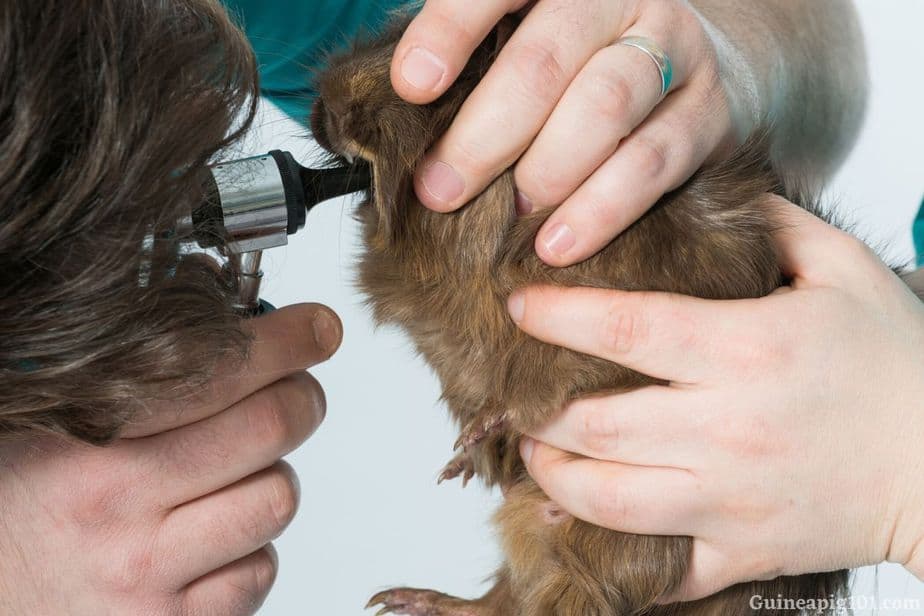
The teeth of guinea pigs always grow. So it is essential to give the toys, enough hay, or other roughage to your guinea pig throughout their life to wear down their teeth at a more accessible level.
Also, this wear can help to avoid painful dental diseases from arising up later in their life.
One of the common problems that a guinea pig needs constant veterinary surgeon care for is dental disease.
An old guinea pig is more prone to dental disease because of the ongoing changes in its structure and skull shape over time.
That can give rise to malocclusion, which is when the guinea pig’s teeth are not arranged correctly, then it can cause guinea pigs teeth to grow out of control.
For guinea pigs, these types of conditions are excruciating, and even it can interfere with their grooming and eating.
Luckily, most of the dental diseases can be recognized in stages, and it can be detected earlier enough to avoid the horrible conditions.
However, the dental disease won’t be fixed on their own. Take your guinea pig to the veterinary surgeon if your guinea pig shows the following symptoms:
- The swelling around their jaw or mouth
- Loss in weight
- Refuse to eat
- Producing fewer feces
- Continually dropping the saliva from the mouth
Bumblefoot (Pododermatitis)
Bumblefoot (Pododermatitis), commonly known as sore hocks, is that kind of condition in which many old guinea pigs can be liable to get on their back legs.
Mainly, this condition infects the bottom of their hocks, and their feet are just like the heels of a guinea pig. The bumblefoot is identified by:
- Redness
- Scabs
- Harder skin on the hock
- The loss of hairs on the infected foot
- Open wounds
- Swelling
Bumblefoot can’t be healed without the treatment, as it can be excruciating for your guinea pig. The veterinary surgeon can clean out the injuries and advise you some mild painkillers.
Mats, carpets, layout blankets, or other soft surfaces in the enclosure of guinea pig and play area to relieve the pressure that it puts on their hocks can help in the healing process.
Also, most of the time, you need to clean the soft things and these blankets to ensure that their wounds remain clean. If your guinea pig is overweight, you need to adjust the diet of your guinea pig to help them lose weight.
Heart disease
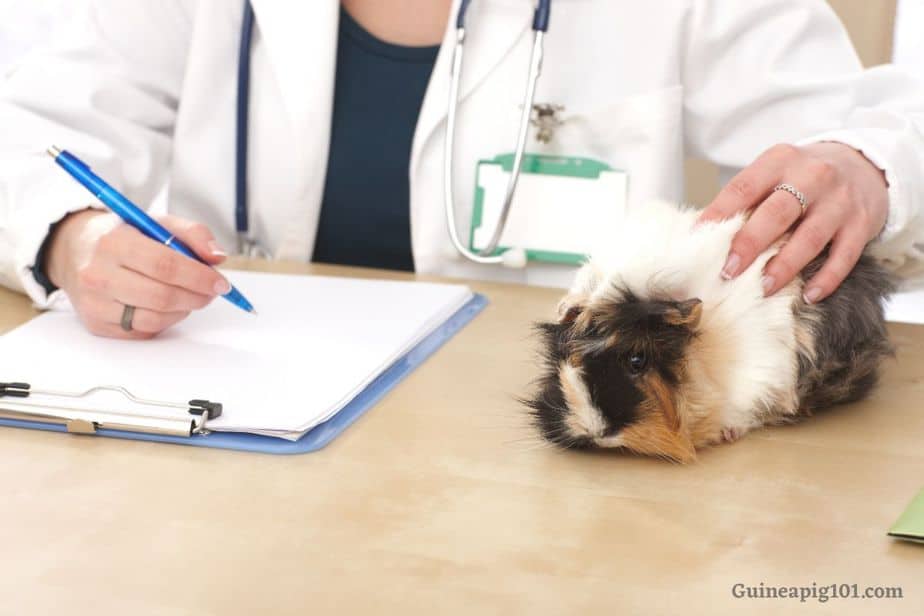
The age of guinea pigs can stiffen the aorta, which is the major artery that supplies the oxygenated blood to the guinea pig’s heart.
Hence, this can lead to irregular heartbeats, and it can also cause sudden life-threatening cardiac conditions as well.
When a guinea pig is stressed enough, even then, they can suffer from a heart attack.
If you notice that your guinea pig is eating less, having problems breathing or moving around, coughing more, and losing weight at a terrible rate, this means that your old guinea pig has a heart problem.
If you observe any of these signs, then you need to take the guinea pig to your veterinary surgeon immediately. It can be life-threatening if you fail to do so.
You need to know that your guinea pig will hide the signs of their pain until their situation gets terrible.
The veterinary surgeon will inject the isotonic saline to reduce the pain and other therapies and improve cardiac reduction.
Your veterinary surgeon will also recommend to you how best you can change the diet of your guinea pig. Often, low heart health can be avoided by feeding the high-fiber, low-fat diet to your guinea pig.
Respiratory illness
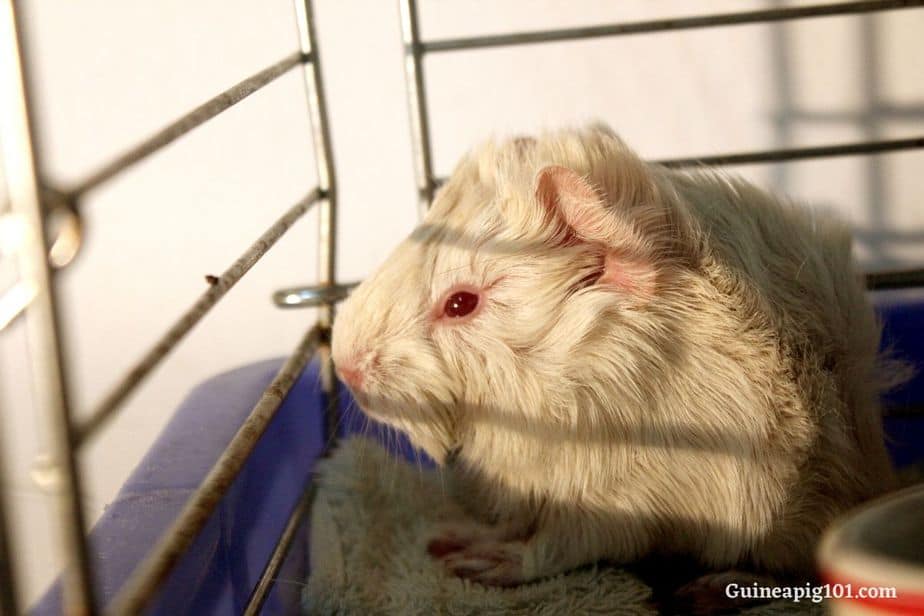
The symptoms of respiratory illness in guinea pigs are similar to the symptoms of heart conditions, making observing their health and behavior all the more essential. Your guinea pig may start sneezing and can produce the nasal discharge.
If a guinea pig is living in a dusty or dirty enclosure or has been encountered with an infected creature, it can develop the problems of respiration.
Try to do your best to keep the playing area and the enclosure of your guinea pig clean and free from any dust and dirt for some time.
Your veterinary surgeon can also specify some antibiotics if infections caused your guinea pig’s respiratory illness.
Also read: Normal breathing and abnormal breathing in guinea pigs
Urinary tract problems
An excess amount of calcium can also cause urinary tract problems. That is a condition in which a bacteria is developed in the guinea pig’s bladder which can cause bloody, painful urination.
Allow your guinea pig to do the exercise regularly and feed them with a proper diet to avoid the urinary tract problem easily.
That is why the play area and enclosure of your guinea pig must be large enough for them to sleep, consume, and go to the bathroom in different places.
If a guinea pig is living in a smaller area, then they can develop health problems.
Kidney diseases
The signs of kidney disease in guinea pigs are the existence of stones in the kidney or high attentiveness of creatinine and urea in the blood.
Generally, the above symptoms can be caused by the high quantities of calcium in the guinea pigs’ diet. Thus, to prevent kidney disease, your guinea pig needs to eat the calcium in less quality.
Your guinea pig can suffer from kidney disease if you observe that they drink enough water, have a loss in weight, peeing a lot, or being depressing.
Kidney disease can cause a life-threatening condition for guinea pigs, so you immediately need to take them to your veterinary surgeon.
Tumors and cancer
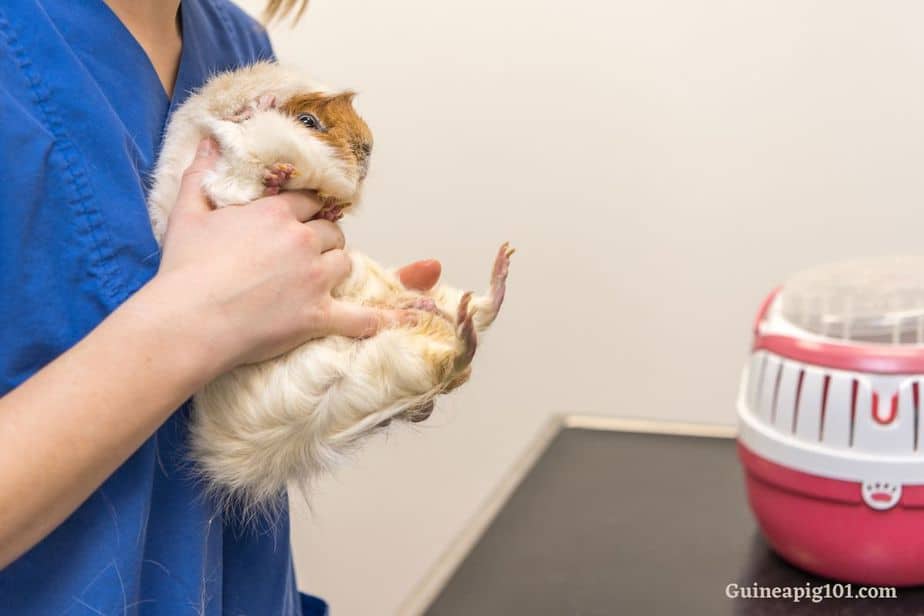
A female guinea pig is mainly at risk for many different kinds of cancer. The most common type of cancer that a female guinea pig can develop is uterine cancer, mostly if you don’t get spay on time.
All the unspayed female guinea pigs, around 70% of them, who are 3 years old or older, can develop uterine cancer.
You should spay the guinea pig when they reach 5 to 6 months old to prevent uterine cancer completely from forming.
If you saw the bloody urine from your female guinea pig, then they can have uterine cancer
The veterinary surgeon will very quickly treat uterine cancer if it is detected earlier. Before cancer spreads very far, all veterinary surgeons should have to do the surgery to remove the ovaries and uterus.
A female guinea pig can also develop mammary cancer made up of tumors found within the mammary gland. If mammary cancer is detected earlier, then it can be treated just like uterine cancer.
The veterinary surgeon will advise limiting the movement of your guinea pig until they heal entirely from the survey.
Hence, you should have to limit them to the play area, which should be small, which prevents them from jumping and provides them with no barriers.
Some of the old guinea pig age symptoms can begin to clear, once your guinea pig reaches 6 years old or older. You have to pay special attention to their behavior and health at this stage to detect these symptoms earlier.
Also, there are many things that you can do to relieve the transition of your guinea pig into old age.
You need to feed your guinea pig with a balanced diet full of fiber, limited pellets, and dark leafy greens to make sure that they remain healthy.
Also, you need to take your guinea pig to the veterinary surgeon every single year so that your veterinary surgeon can detect any symptoms of severe health disorders in an early stage.
Source: Health issues in Guinea Pigs, Disorders and Diseases of Guinea Pigs, Disease Problems of Guinea Pigs, Biology and Diseases of Guinea Pigs.
Similar Posts:
- Why Does My Guinea Pig Have A Double Chin?
- Bumblefoot in Guinea Pigs (Pododermatitis): Causes, Signs & Treatment
- Gastrointestinal Stasis in Guinea Pig: Digestive Problems in Guinea Pigs
- Guinea Pig Heart Attack: Signs, Symptoms, Causes, and Treatment
- What Should Guinea Pig Poop Look Like? (Normal & Abnormal Poop)
